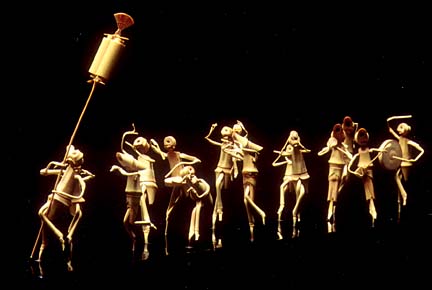

[GALLERY]
ON VIEW IN THE ISLANDS

NANCY MOORE BESS'S discovery of bamboo treasures began with five eggs bundled up in rice straws. The Massachusetts basket maker (then living in Manhattan) became fascinated by Japanese aesthetics about 20 years ago after reading "How to Wrap Five More Eggs," a book on Japanese packaging with natural materials. Bamboo’s beauty
just part of its valueBy Suzanne Tswei
Star-Bulletin"I just thought the Japanese had a beautiful way of doing things, and the forms were related to the vessels I was doing at the time. As a maker of baskets, I was influenced by how the Japanese used natural material -- paper, rice straw and bamboo, and I wanted to learn more," Bess said.
Her fascination led to a scholarly and artistic passion specifically for bamboo, resulting in a collection of Japanese bamboo objects and a book, "Bamboo in Japan," being published by Kodansha International of Japan.
Her collection is being shown in an exhibit that opens today at East-West Center with a free slide lecture by Bess. The collection is supplemented by pieces from the Honolulu Academy of Arts and Hawaii collectors. A small display of Bess's own baskets also is on view in a hallway adjacent to the exhibit in John A. Burns Hall.
Place: East-West Center Gallery, Burns Hall Bamboo in Japanese Culture:
Traditional, Ritual, PracticalHours: 8 a.m. to 5 p.m. weekdays, noon to 4 p.m. Sunday, through June 29, public opening reception 5 to 7 pm., Tuesday (April 10)
Cost: Free
Call: 944-7111
related events
Slide Lecture: By Nancy Moore Bess, 2 to 3 p.m. today, free
Concert: Silk & Bamboo: A Concert of Japanese Music, 4 to 5:30 p.m. today, Jefferson Hall. Tickets are $10; $8 for students and seniors. Call 944-7177.
Her book, with some research conducted in libraries at the University of Hawaii and the academy, will be available for purchase at the center's publications office for $50 each in early May.
"In Japan, bamboo is everywhere. That was something I didn't expect," Bess said. "It is not just this romanticized, traditional thing used in tea ceremonies. It is very contemporary, used for all kinds of things and growing everywhere."
Among the first sights that impressed her after landing in Narita Airport on her first trip to Japan were large groves of bamboo along the roadway. In her travels through Japan over the years, she was startled, pleasantly, by the purple glow of young bamboo peaking out of the ground at a temple, and the soothing sound of rustling bamboo on a winding road to a small country train station.
She discovered the many uses of bamboo, from simple chopsticks and garden fences to the skeletons of waxed paper umbrellas and intricate baskets.
"I had no idea how wide the range of items bamboo is used for, or how beautiful the patina. It just took my breath away," Bess said.
Bamboo's contribution to Japanese culture goes far beyond a countryside grove or man-made objects, Bess said. Bamboo is in every part of Japanese daily life, leaving its imprint in art, literature, design, food and crafts.
Bess' collection aims to reflect the varied aspects of bamboo in Japanese culture. Her collection includes humble everyday household utensils, as well as treasured one-of-a-kind creations from craftspeople. The exhibit also features paper stencils of bamboo patterns and bamboo designs on fabric, ceramics and other objects.
"I love that traditionally in Japan there was no division made between art and craft," said Bess, who's more comfortable being labeled an artisan than artist. It wasn't until Japan came under Western influence in the 20th century that everyday hand-made objects lost ground to art.
"Things that are beautifully made are very sensual and very appealing to us. That's what art is ... and that can be a ceramic bowl made by a famous artist or a piece of cut bamboo by some anonymous craftsperson," she said.
Bamboo objects often are simple, traditional and created for everyday use without artistic pretensions, like fans, rice paddles or food containers. But the craftspeople who made them created them with care, attention to design, and respect for the intrinsic beauty of the natural material, Bess said. The result is a Japanese aesthetic renowned the world over.
"It's something indescribable that makes you look at something the second or third time. Everything about it just makes you want to look at it again. You just can't take your eyes off of it," she said.
Click for online
calendars and events.